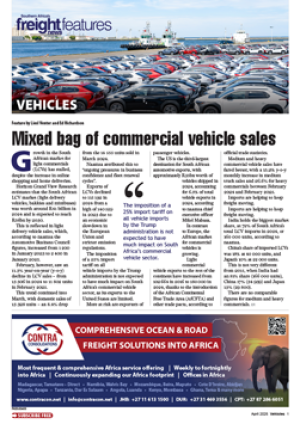As part of its efforts to curtail
the overloading of road
transport vehicles,
the government
has just enacted
a series of new
regulations
under the
National
Road Traffic
Act 1996.
And,
according to a
legal opinion released to FTW,
while these are rather vague in
nature, their imposition from
an effective date of February
1 could see any person
contravening the
amended act being
hit with a heavy
fine – or even up to
a year in jail.
Don’t relax if
you’re the person
contracting the
transport or the one
receiving the sent
goods. Now you, along
with the road transporter,
could be found guilty of
the offence.
This is because the
new regulations on
overloading
stipulate that: “A consignor or
consignee is prohibited from
offering goods or accepting
goods, as the case may be, if the
vehicle is not loaded in terms of
the Act (Regulation 330A(1)”.
And, added to that, is a
second clause stating: “The
regulations also prohibit a
consignee or consignor from
concluding a contract with
an operator if the vehicle is
overloaded (Regulation 330A
(4)”.
So it’s not like the old days
when you (as a consignor or
consignee) could say: “It’s not
my fault”.
As part of his advice memo
to members, Kevin Martin,
chairman of the Durban
Harbour Carriers’ Association
(DHCA), focused on this triple
whammy. “The law,” he told
FTW, “should bring the present
‘double loading’ of heavy
containers to an immediate
end – as this is an unfair and
unlawful practice. It will now
make both the loading point
and the receiving point liable
for prosecution – and not just
the transporter.
“Further, liability cannot
be contracted out, so – in the
event of an accident/death/or
claim – the claiming party now
has recourse to the ‘party with
the deepest pockets’ within the
logistics chain, not necessarily
the party directly responsible.”
Now Peter Lamb of the legal
firm Norton Rose Fulbright
was the lawyer who told FTW
about the lack of clarity in the
new regulations. Also, with
certain elements of vagueness
in their wording, enforcement
of these regulations may prove
impossible, he added.
Given this, he focused on the
regulations that were intended
to control overloading.
And the demands made on
the consignor at the time of
loading allow anything but a
thumb-suck estimation of the
load.
“These additional obligations
that the regulations impose on
a consignor are breath-taking
when one considers what
facilities a consignor would
need to have access to in order
to comply with them,” said
Lamb. “He’d need to have, for
example, weighbridges or other
mass-measuring apparatus.”
The regulations require the
consignor to have a method
of determining the mass of a
vehicle and any axle or axle unit
of such vehicle. This is to ensure
that the vehicle axle or axles
are not overloaded in terms of
the National Roads Traffic Act
(Regulation 330B(1).
Lamb also noted that a
consignor was now obliged to
keep a record of the mass of
every load transported from his
premises (Regulation 330B (2),
and that this had to be made
available to any traffic officer
upon demand (Regulation
330B (3).
“So, in summary,” said
Martin, “the consignor is
obliged to obtain from the
operator a written submission
as to the payload of the vehicle
and the distribution of the load
on the vehicle. He must have in
place a method of determining
the mass of a vehicle and
any axle or axle unit of such
vehicle. And he must keep a
record of the mass of every load
transported from his or her
premises.”
As his contribution to
avoiding overloading, Martin
told FTW that details of
his vehicle fleet’s maximum
payloads would be on every
vehicle.
“When it comes to loading to
a vehicle’s maximum payloads,
all vehicles have a ‘theoretical
payload’ (where load
distribution is perfect – or ‘on
a match stick’ as the colloquial
term goes) and a practical
‘working mass’ payload.
“All payloads I have given
are of the latter – practical
working mass payloads
“I suggested to all the
DHCA members that they also
supply these details to all their
loading and off-loading points
– the packing
stations and
terminals.”
And bringing
the consignee
into the
overloading
regulations
also has its
own unclear
legislative area,
according to
Lamb.
“The
consignee,”
he said, “is
prohibited from
accepting goods if the vehicle
is not loaded and transported
in accordance with the act.
He/she is also prohibited from
entering into a contract with
the operator to transport
the goods if the vehicle is
overloaded.”
Just how a consignee – who
is totally separate from the
vehicle loading procedure
– would know whether
the vehicle was loaded in
accordance
with the
act is one
unclear area,
according
to Lamb.
Or what
additional
steps the
consignee
would need to
take to ensure
compliance,
presumably
on the part of
the operator,
with the act.
“The regulations create
a further anomaly,” he told
FTW, “and assume that the
time of entering into the
contract to transport the
goods occurs at the same
time the goods are loaded.
“But, in practice, these
contracts may be entered
into well before the
goods are loaded onto the
transporting vehicle.”
In Lamb’s opinion, if
the operator ‘breaches’ the
contract by subsequently
overloading the vehicle, the
consignee may arguably have
no right of recourse against
the operator.
“One of the requirements
to enter into a contract is
that the contract must be
lawful,” he added. “In effect,
the regulations render the
contract to be unenforceable
as it is expressly prohibited
by Regulation 330(A).
“This outcome is
irrational. However, until
the Regulations are
amended to rectify this
anomaly, we recommend that
consignees and consignors
comply with Regulation
330A as far as possible.”
INSERT & CAPTION 1
With certain elements
of vagueness in
their wording,
enforcement of these
regulations may prove
impossible.
– Peter Lamb
INSERT & CAPTION 2
The new regulations
make both the
loading point and
the receiving point
liable for prosecution
— and not just the
transporter.
– Kevin Martin

